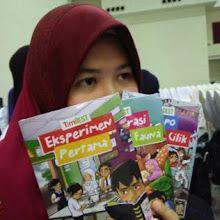
Pendek kata, semua yang haram itu jika dibuat memang berdosa...
Adakah diri ini sedang menambah dosa ataupun menambah pahala?
------------------------------------------------------
Pada suatu senja yang lenggang, terlihat seorang wanita berjalan terhuyung-huyung. Pakaianya yang serba hitam menandakan bahwa ia berada dalam dukacita yang mencekam. Kerudungnya menangkup rapat hampir seluruh wajahnya. Tanpa hias muka atau perhiasan menempel di tubuhnya. Kulit yang bersih, badan yang ramping dan roman mukanya yang ayu, tidak dapat menghapus kesan kepedihan yang tengah meruyak hidupnya. Dia melangkah terseret-seret mendekati kediaman rumah Nabi Musa a.s.
Diketuknya pintu pelan-pelan sambil mengucapkan uluk salam.Maka terdengarlah ucapan dari dalam "Silakan masuk". Perempuan cantik itu lalu berjalan masuk sambil kepalanya terus merunduk. Air matanya berderai tatkala ia berkata, "Wahai Nabi Allah. Tolonglah saya. Doakan saya agar Tuhan berkenan mengampuni dosa keji saya.
"Apakah dosamu wahai wanita ayu?" tanya Nabi Musa a.s. terkejut. "Saya takut mengatakannya. "jawab wanita cantik. "Katakanlah jangan ragu-ragu!" desak Nabi Musa.Maka perempuan itupun terpatah bercerita, "Saya... telah berzina. "Kepala Nabi Musa terangkat,hatinya tersentak. Perempuan itu meneruskan, "Dari perzinaan itu saya pun... lantas hamil. Setelah anak itu lahir,langsung saya... cekik lehernya sampai... tewas," ucap wanita itu seraya menangis sejadi-jadinya.
Nabi Musa berapi-api matanya. Dengan muka berang ia mengherdik, "Perempuan bejad, enyah kamu dari sini! Agar siksa Allah tidak jatuh ke dalam rumahku karena perbuatanmu. Pergi!"... teriak Nabi Musa sambil memalingkan mata karena jijik.
Perempuan berwajah ayu dengan hati bagaikan kaca membentuk batu, hancur luluh segera bangkit dan melangkah surut. Dia terantuk-antuk keluar dari dalam rumah Nabi Musa. Ratap tangisnya amat memilukan. Ia tak tahu harus kemana lagi hendak mengadu. Bahkan ia tak tahu mau dibawa kemana lagi kaki-kakinya. Bila seorang Nabi saja sudah menolaknya, bagaimana pula manusia lain bakal menerimanya? Terbayang olehnya betapa besar dosanya, betapa jahat perbuatannya. Ia tidak tahu bahawa sepeninggalnya, Malaikat Jibril turun mendatangi Nabi Musa. Sang Ruhul Amin Jibril lalu bertanya, 'Mengapa engkau menolak seorang wanita yang hendak bertaubat dari dosanya? Tidakkah engkau tahu ada dosa yang lebih besar daripadanya.'
Nabi Musa terperanjat. "Dosa apakah yang lebih besar dari kekejian wanita pezina dan pembunuh itu?" Maka Nabi Musa dengan penuh rasa ingin tahu bertanya kepada Jibril. "Betulkah ada dosa yang lebih besar daripada perempuan yang nista itu?"
" Ada !" jawab Jibril dengan tegas. "Dosa apakah itu?" tanya Musa kian penasaran."Orang yang meninggalkan sholat dengan sengaja dan tanpa menyesal. Orang itu dosanya lebih besar dari pada seribu kali berzina".Mendengar penjelasan ini Nabi Musa kemudian memanggil wanita tadi untuk menghadap kembali kepadanya. Ia mengangkat tangan dengan khusuk untuk memohonkan ampunan kepada Allah untuk perempuan tersebut.
Nabi Musa menyadari, orang yang meninggalkan sembahyang dengan sengaja dan tanpa penyesalan adalah sama saja seperti berpendapat bahwa sembahyang itu tidak wajib dan tidak perlu atas dirinya. Berarti ia seakan-akan menganggap remeh perintah Tuhan, bahkan seolah-olah menganggap Tuhan tidak punya hak untuk mengatur dan memerintah hamba-Nya. Sedang orang yang bertobat dan menyesali dosanya dengan sungguh-sungguh berarti masih mempunyai iman di dadanya dan yakin bahwa Allah itu berada di jalan ketaatan kepada-Nya. Itulah sebabnya Tuhan pasti mau menerima kedatangannya.
(Dikutip dari buku 30 kisah teladan - KH Abdurrahman Arroisy
Dalam hadis Nabi SAW disebutkan : Orang yang meninggalkan sholat lebih besar dosanya dibanding dengan orang yang membakar 70 buah Al-Qur'an,membunuh 70 nabi dan bersetubuh dengan ibunya di dalam Ka'bah.
Dalam hadis yang lain disebutkan bahwa orang yang meninggalkan sholat sehingga terlewat waktu, kemudian ia mengqadanya, maka ia akan disiksa dalam neraka selama satu huqub.Satu huqub adalah delapan puluh tahun. Satu tahun terdiri dari 360 hari, sedangkan satu hari diakherat perbandingannya adalah seribu tahun di dunia.
Demikianlah kisah Nabi Musa dan wanita pezina dan dua hadis Nabi, mudah-mudahan menjadi pelajaran bagi kita dan timbul niat untuk melaksanakan kewajiban solat dengan istiqomah.
Wassalamu'alaikum wbt..
Dan hendaklah ada di antara kamu segolongan umat yang menyeru kepada kebajikan, menyuruh kepada yang ma'ruf dan mencegah dari yang munkar; merekalah orang-orang yang
beruntung. (QS. Ali Imran 104:105)
"Qul, Amantu bil-Lahi, tsumnas-taqim" Katakanlah! Aku percaya kepada Allah dan kemudian pegang teguhlah pendirian itu.
Tolong sebarkan kepada saudara-saudara kita yang belum mengetahui.
(Sumber: Hidayahnet)
